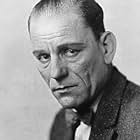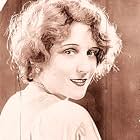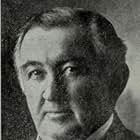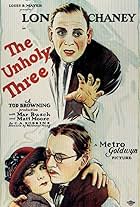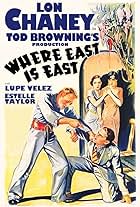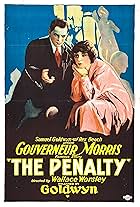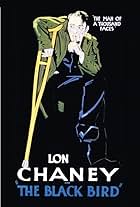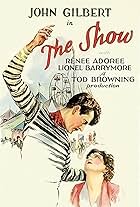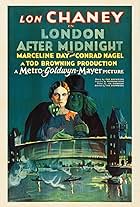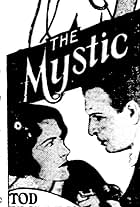A magician seeks vengeance upon the man who paralyzed him and the illegitimate daughter he sired with the magician's wife.A magician seeks vengeance upon the man who paralyzed him and the illegitimate daughter he sired with the magician's wife.A magician seeks vengeance upon the man who paralyzed him and the illegitimate daughter he sired with the magician's wife.
Chaz Chase
- Music Hall Performer
- (uncredited)
Rose Dione
- Zanzibar Club Owner
- (uncredited)
Louise Emmons
- Old Woman on Street
- (uncredited)
Fred Gamble
- Vaudeville Comedian
- (uncredited)
Emmett King
- Stage Manager
- (uncredited)
Dick Sutherland
- Cannibal
- (uncredited)
Edna Tichenor
- Dancing Girl in Zanzibar Club
- (uncredited)
Art Winkler
- Stagehand
- (uncredited)
Art Winkler
- Stagehand
- (uncredited)
Dan Wolheim
- Zanzibar Club Customer
- (uncredited)
Storyline
Did you know
- TriviaIn the ceremonial tribal dances the local extras had difficulty dancing to the drums.To remedy the situation a radio was brought to the set and played Jazz tunes by a local station.
- GoofsWhen the natives are crossing the river with the ivory tusks and Tiny appears as the evil spirit, they drop the tusks and run. The tusks float on the water.
- Quotes
Phroso 'Dead-Legs': I'm particular who I eat with. Feed her on the floor!
Doc: I'm down pretty low, but not so far that I'll stand for this.
Phroso 'Dead-Legs': Yair? Well, you'll stand for anything *I* say.
Maizie: Say, Mister! Don't get in trouble on account of me.
Doc: I'll eat with her. I'm particular about who I eat with, too.
- Alternate versionsMGM also released this move without any soundtrack.
- ConnectionsEdited into Kongo (1932)
Featured review
This is one of Silent star Lon Chaney’s most popular and intriguing titles, the penultimate of ten collaborations with director Browning (being virtually a dead cert for an eventual second DVD set of the star’s vehicles from Warners but which has been so long in coming that I opted to acquire it from ulterior sources – culled from the quite extensively scratched print shown on “TCM Underground”). Though this was my first time watching the film, I was already familiar with the plot via a relatively recent viewing of its almost-as-good Sound remake – KONGO (1932), where Chaney was replaced by Walter Huston (who had actually originated the role on stage). Revolving as it does around a long-running, elaborate and, finally, tragically ironic revenge, the material is just what audiences had come to expect of the “Man Of A Thousand Faces” (here utilizing simple yet effectively distinct make-ups for the opening sequence and the rest of the film, occurring eighteen years later) – the star having made this kind of intense, grim entertainment practically his own over the years.
The first difference I noticed between the two versions is that, despite being the shorter film, WEST OF ZANZIBAR (running 65 minutes against KONGO’s 86) takes care to depict the incident which crippled and soured Chaney’s character (he’s subsequently referred to almost exclusively as “Dead-Legs”!) – whereas Huston is already ‘crawling around’ when the narrative takes off. Having said that, some of the developments in the storyline are kind of rushed through here – but, then, I recall feeling the same way about the girl’s degradation in KONGO; on the other hand, in the latter film but not here, we get an additional major (albeit perfunctory) character – Huston’s bitter girlfriend played by Lupe Velez. Apart from that, C. Henry Gordon, Conrad Nagel and Virginia Bruce seemed to me to have stood in adequately for Lionel Barrymore, Warner Baxter and Mary Nolan respectively from the 1928 version.
By the way, back then, I had voiced my doubts about the presence in the original of two particular scenes from KONGO: the ‘gimmicks’ utilized to dupe the superstitious locals – since many of them were borrowed from Browning’s THE SHOW (1927), which had featured Barrymore in a similar role – weren’t, in fact, duplicated into WEST OF ZANZIBAR (where they are of a more modest if still attention-grabbing nature); however, the ending – in which the natives turn on Chaney’s confidence trickster/demi-God a' la H.G. Wells’ “The Island Of Dr. Moreau” (this happened to be filming around the same time as KONGO!) – is identical in the two versions. The jungle/squalid atmosphere, too, is pretty much equal in both titles – in retrospect, the fact that the latter film followed the visual style of the original so closely shouldn’t detract from its ultimate quality but rather reflect upon otherwise obscure director William J. Cowen’s good judgment (or, if you like, shrewdness). However, at the end of the day, Chaney’s typically mesmerizing performance and Browning’s undeniable flair for low-life/exotic melodrama are the two driving factors which give the original the edge; besides, for all its better-rounded characterizations, I remember KONGO being bogged down by meaningful, self-pitying talk – here everything is deployed in purely cinematic terms and accentuated, of course, by the emotive acting redolent of the Silent era…
The first difference I noticed between the two versions is that, despite being the shorter film, WEST OF ZANZIBAR (running 65 minutes against KONGO’s 86) takes care to depict the incident which crippled and soured Chaney’s character (he’s subsequently referred to almost exclusively as “Dead-Legs”!) – whereas Huston is already ‘crawling around’ when the narrative takes off. Having said that, some of the developments in the storyline are kind of rushed through here – but, then, I recall feeling the same way about the girl’s degradation in KONGO; on the other hand, in the latter film but not here, we get an additional major (albeit perfunctory) character – Huston’s bitter girlfriend played by Lupe Velez. Apart from that, C. Henry Gordon, Conrad Nagel and Virginia Bruce seemed to me to have stood in adequately for Lionel Barrymore, Warner Baxter and Mary Nolan respectively from the 1928 version.
By the way, back then, I had voiced my doubts about the presence in the original of two particular scenes from KONGO: the ‘gimmicks’ utilized to dupe the superstitious locals – since many of them were borrowed from Browning’s THE SHOW (1927), which had featured Barrymore in a similar role – weren’t, in fact, duplicated into WEST OF ZANZIBAR (where they are of a more modest if still attention-grabbing nature); however, the ending – in which the natives turn on Chaney’s confidence trickster/demi-God a' la H.G. Wells’ “The Island Of Dr. Moreau” (this happened to be filming around the same time as KONGO!) – is identical in the two versions. The jungle/squalid atmosphere, too, is pretty much equal in both titles – in retrospect, the fact that the latter film followed the visual style of the original so closely shouldn’t detract from its ultimate quality but rather reflect upon otherwise obscure director William J. Cowen’s good judgment (or, if you like, shrewdness). However, at the end of the day, Chaney’s typically mesmerizing performance and Browning’s undeniable flair for low-life/exotic melodrama are the two driving factors which give the original the edge; besides, for all its better-rounded characterizations, I remember KONGO being bogged down by meaningful, self-pitying talk – here everything is deployed in purely cinematic terms and accentuated, of course, by the emotive acting redolent of the Silent era…
- Bunuel1976
- Sep 26, 2008
- Permalink
- How long is West of Zanzibar?Powered by Alexa
Details
- Release date
- Country of origin
- Language
- Also known as
- Los pantanos de Zanzíbar
- Filming locations
- Production company
- See more company credits at IMDbPro
Box office
- Budget
- $259,000 (estimated)
- Runtime1 hour 5 minutes
- Sound mix
Contribute to this page
Suggest an edit or add missing content










